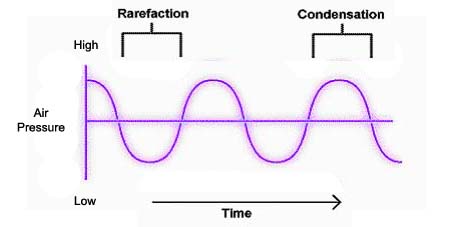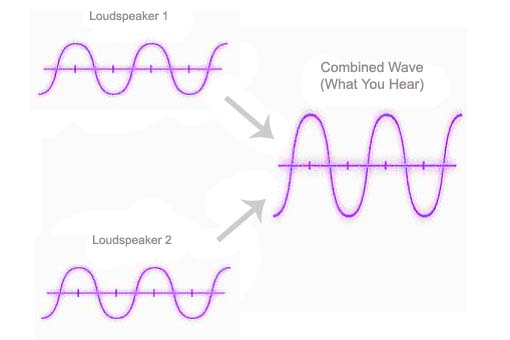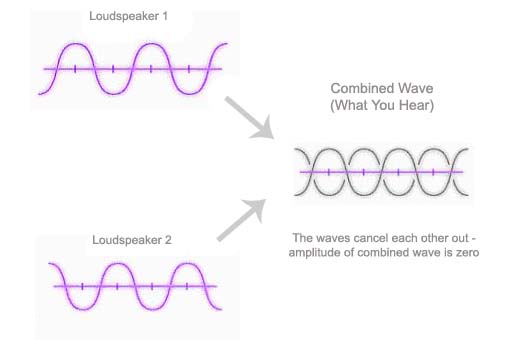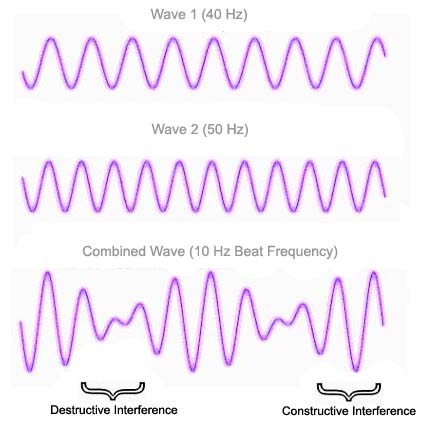The Physics of Sound
What is Sound?
Put simply, sound is vibration. As such, sound can pass through many different substances - in fact, it requires the presence of a medium. Sound cannot travel in a vacuum.
The most common medium within which we perceive sound is, of course, air. Various movements around us cause vibrations in air molecules, and this sound energy is transported outwards as waves. Much in the same way as waves move across the surface of a pond, so does sound move through the air. Once the action that caused the waves ceases, then the pond will gradually return to its original position, as if nothing had happened.
Sound also travels through water, and can travel through solids too, such as wood, brick, iron and so on. The ease with which it can do so depends upon the composition of the medium, and the nature of the sound itself. Different frequencies can move more easily through certain substances than others, and some frequencies travel further than others. Approaching a concert, for example, you may well hear the thumping of the bass drum before all else.
Waves travel as a transfer of energy within a medium - a wave is essentially a sequence of compressions (moving together) and rarefactions (moving apart) of molecules.

Properties Of A Wave
A number of properties are commonly used to define a wave. The wavelength may be defined as the horizontal distance between two successive equivalent points on the waveform. For convenience, these two points are usually taken at peaks (highest point) or troughs (lowest).
The period then is the time it takes for the wave to complete one full cycle.
The amplitude equates to the height of the wave; loud sounds produce waves of higher amplitude. The loudness or intensity of sound is measured in decibels; however, it must be remembered that this is not a linear or absolute scale of measurement. The lowest threshold of human hearing is set at zero; a decibel is sometimes defined as the smallest change in volume discernable by a human. For a doubling in volume, the decibel level goes up by six. Within this scale, normal speech levels fit in at around 60dB.
The frequency of a wave is the number of cycles that pass a set point in a second, and is measured in Hertz (Hz). Frequency is intimately connected to pitch, although they are not exactly synonymous; the A above middle C is a vibration at a rate of 440 Hz. Lower frequency vibrations are perceived as being lower in pitch, and higher frequencies seem higher in pitch.
Basic Interference Patterns
Sound, like all waves, rarely occurs in isolation. Every day, the world around us is awash with sounds, from the rustling of leaves to the roaring of engines. All of these sounds interact with one another, and with all the elements and obstacles of their environment. Hence, the same sound sources can sound vastly different depending upon the position of the listener in relation to them.
A practical example can illustrate how soundwaves interfere with one another. We can set up two loudspeakers located at a distance of three metres from the listener. The speakers are producing the same tone, with a wavelength of one metre. The speakers� diaphragms are also moving in synchrony - that is, they both move in and out at the same time.

As the distances are equal, the compressions of each wave (peaks) are reaching the listener at the same time. A process of linear superposition then occurs - the combined pattern of the waves is the sum of the individual wave patterns. As the pressure of both waves is waxing at the same time, the pressure fluctuations where the two waves meet exhibits twice the amplitude of the individual waves. This means that the waves are exactly in phase - creating a condition known as constructive interference.
However, if one of the speakers is moved half a wavelength further away from the listener (in this example, half a metre), then an entirely different effect will be observed. The rarefactions (troughs) of one of the waves will now reach the listener at the same time as the compressions (peaks) of the other. Following the same additive principles as before, the variations in air pressure now cancel each other out. This is destructive interference, when two signals are perfectly out of phase. Noise-cancelling headphones use this technique to reduce unwanted ambient sounds.

Beat Patterns
Now that we know what happens when two sound waves with the same frequency overlap, let's explore what happens when two sound waves with different frequencies overlap. Two instrument tuners are placed side by side, one set to emit a sound whose frequency is 440 Hz and the other set to emit a sound whose frequency is 438 Hz. If the two tuners (which have the same amplitude) are turned on at the same time, you will not hear a constant sound. Instead, the loudness of the combined sound rises and falls. Whenever a condensation meets a condensation or a rarefaction meets a rarefaction, there is constructive interference and the amplitude increases. Whenever a condensation meets a rarefaction and vice versa, there is destructive interference, and you can hear nothing. These periodic variations in loudness are called beats. In this situation you will hear the loudness rise and fall 2 times per second because 440-438=2. So, there is a beat frequency of 2 Hz. Musicians listen for beats to hear if their instruments are out of tune. The musician will listen to a tuner that has the correct sound and plays the note on his intrument. If the musician can hear beats, then he knows that the instrument is out of tune. When the beats disappear, the musician knows the instrument is in tune.

